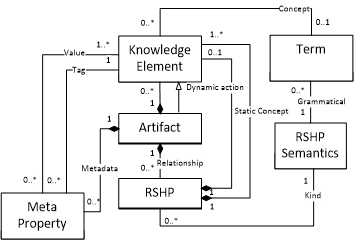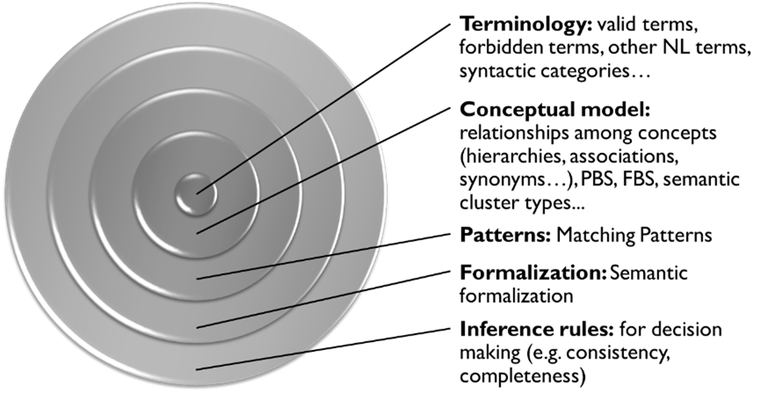Knowledge-Centric System Artefact Quality Analysis
Knowledge-centric system artefact quality analysis [KCQ3] was developed in the AMASS project [KCQ1]. It is based on the RSHP model [KCQ2] (figure below), which allows the representation of any type of information or knowledge about a domain, including the semantics of the element under consideration. RSHP enables knowledge-centric systems engineering, which is a specialisation of model-based systems engineering based on the idea that all systems engineering processes are affected by the existence of a knowledge base (ontology) about a system and its lifecycle.

Knowledge bases can be represented as ontologies with the structure shown in the figure below. Such ontologies support system artefact quality analysis according to the information in the different layers:
- The most inner layer (Terminology) corresponds to the terms of a domain together with their syntactic information, e.g., about whether a term such as ‘car’ is a noun.
- Relationships between the terms can be specified in the conceptual model layer, as well as their semantics with clusters; e.g., the semantics of the terms ‘car’ and ‘truck’ can be ‘system’, and they specialise ‘vehicle’.
- Patterns can then be developed to provide templates (aka boilerplates) for system information specification. The patterns refer to aspects of the two underlying layers; e.g. in the pattern “The [System] shall [Detect] [Item] at a minimum range of [Number] seconds”, the elements in squared brackets correspond to semantic clusters.
- The Formalization layer deals with the semantic representation (in RSHP format) of system information according to patterns. This representation can correspond to system artefacts in different formats, e.g., text or a model, and of different types, e.g., requirements and design elements.
- Finally, at the Inference rules layer the data in all the others can be exploited for the specification of procedures to derive information, e.g., about specification correctness.

The knowledge base can be exploited for artefact quality analysis, e.g., to determine if a given requirement contains valid terms or has been correctly specified according to some pattern. Quality can be quantitatively assessed by means of quality functions, which will indicate if artefact quality is good, medium, or bad according to ranges.
As RSHP enables the representation of any type of information, quality analysis can be conducted for different system artefact types (requirements, design…) and in different formats (text, models…).
- Industrial method in use for years
- More consistent and systematic system artefact quality analysis
- The method can be tailored to any system artefact type
- There exist many types of system artefacts and the analysis of some is not supported
- No empirical evidence of cost-effectiveness
- [KCQ1] AMASS Project: Deliverable D3.3 - Design of the AMASS tools and methods for architecture-driven assurance (b). 2018
- [KCQ2] Llorens, J., Morato, J., Genova, G.: RSHP: an information representation model based on relationships. In Soft computing in software engineering. Springer. 2004
- [KCQ3] Parra, E., Alonso, L., Mendieta, R., de la Vara, J.L.: Advances in Artefact Quality Analysis for Safety-Critical Systems. 30th International Symposium on Software Reliability Engineering (ISSRE 2019)
